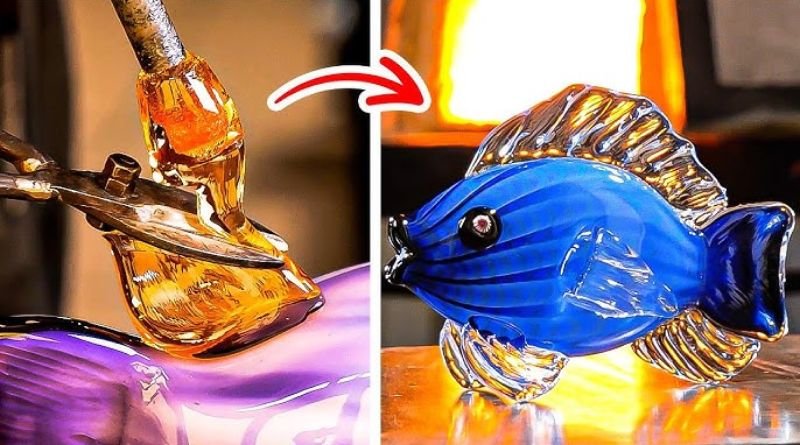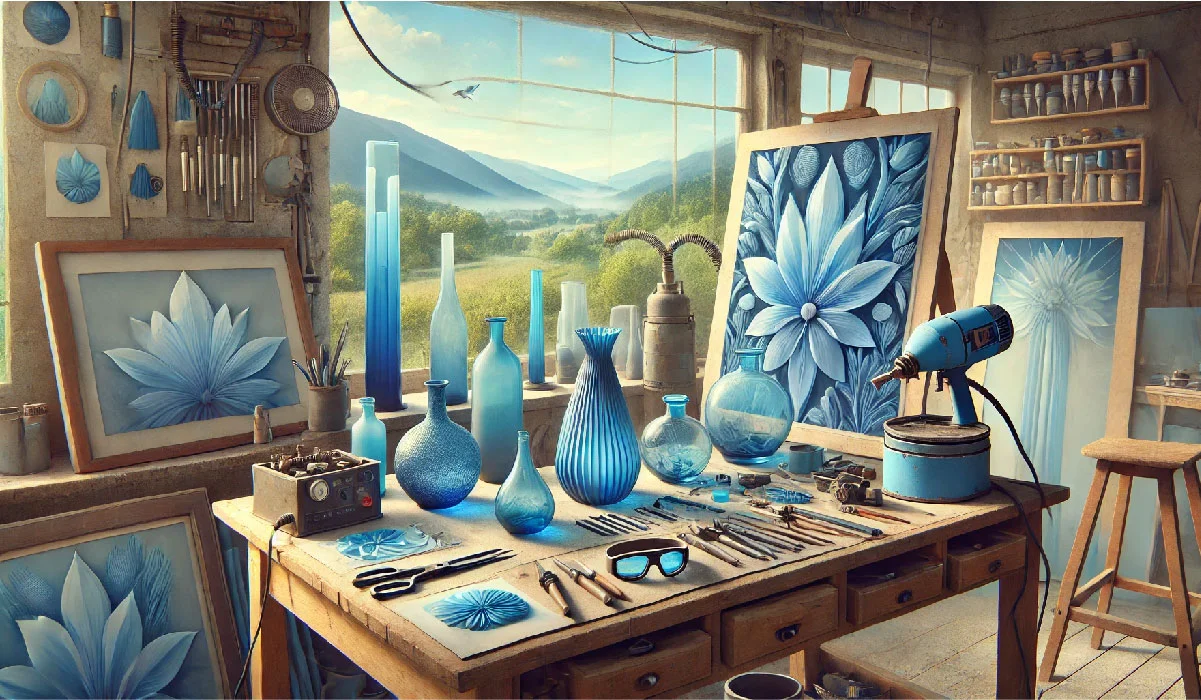Glassmaking is an artistic combination of scientific expertise requiring significant expertise. Among glassmaker techniques cutting and sandblasting present the most critical and thrilling possibilities that fulfill the demand for decorative items including the Cut Blue Glass and Sandblost. The manufacturing process of glass becomes more understandable to everyone from artists to hobbyists and general observers through this method.
The following article explains blue glass cutting and sandblasting combined with historical context and required instruments followed by structured production techniques and their applications for manufacturing elegant glass objects. This article provides all readers with comprehensive understanding of the method which produces attractive functional glass art.
The History of Glass Crafting
The initial instances of glass production can be found within the archaeological record going back to 3500 BCE in the Mesopotamian locations. The scientific development of glass molding techniques proceeded throughout history when researchers from various civilizations tested diverse methods to create functional artistic glass products from the cracked material.
Cut Blue Glass and Sandblost has been used for many generations due to its ancient values as well as its symbolic history. Before modern times blue glass represented royalty as well as spiritual beliefs across various ancient societies because it was considered a precious and highly sought-after material. The centuries-long history shows blue glass as a material that graced both stained glass windows and royal decorations.
The techniques of cutting and sandblasting appeared during a later period of glassmaking history after the industrial revolution allowed them to advance in the 19th century. .SOCK purchased its first sandblasting machine in the late 1800s bringing design etching onto glass surfaces into the modern era.
What is Cut Blue Glass?
Artisans or modern machines produce Cut Blue Glass and Sandblost when they design intricate patterns on blue glass pieces. Production of blue items involves utilizing metal oxides or blue tinted glass products in most cases. Manufacturers create cut blue glass by using abrasive tools and mechanical cutting devices to generate straight lines along with intricate and complex patterns.
The term ‘cut’ specifically refers to both the angular lines and the decorative geometric motifs present on the glass surface. Cuts on decorative items including chandeliers and vases along with jewelry as well as bowls commonly use blue glass for their design. The material finds applications in construction when employed for building elements which require intricate decorative outlines in windows and vertical wall panels.
The visual effect and transparency with intense depth are characteristics that make cut blue glass appealing. When glass undergoes cutting the interaction between light creates unusual and beautiful effects that include both the reflection of light and the production of shadows. This makes the material suitable for interior decoration and artwork functions.
Sandblasting: A Revolutionary Technique in Glass Art
Sandblasting or abrasive blasting functions as an industrial technique to remove surface elements by directing high-pressure air together with abrasive substances like sand. The method applies frost patterns into designs which appear on glass, metal and stone materials.
During the glass sandblasting operation an airflow carries fine grains of abrasive material to the glass surface to extract thin layers of material until the required pattern emerges. The strategy allows you to create complex and detailed patterns or soft texturations. Hotel glass decoration using a sandblasting has gained more popularity over traditional glass painting or engraving techniques because it produces elaborate patterns with high precision.
The versatility of sandblasting functions as the charm in this process. A glass piece can achieve depth when the tool introduces varying degrees of textured surfaces ranging from smooth to heavily etched finishes. Through the sandblasting process one enables the easy addition of customized artwork such as logos, symbols and photographs on glass surfaces. Cut Blue Glass and Sandblost requires sandblasting as an additional process combined with other cutting techniques to produce splendid multi-layered designs.
The Tools and Equipment Required for Cutting Blue Glass
Cutting blue glass serves both purposes of exactness in measurement and technical accuracy simultaneously. Specialized machinery currently enables glassmakers to perform this process so that they achieve accurate results without manual involvement. All requirements for blue glass cutting should include diamond tipped tools, glass cutters, angle grinders, cutting tables, polishing tools and safety equipment.
When dealing with the tough blue glass surface one needs diamond tipped cutters for producing neat precise cuts. Glass cutters serve the purpose of surface scoring so users can break glass along the scored lines therefore ideal for straight lines yet elaborate designs call for angle grinders with diamond blades.
A cutting table enables operators to make accurate controlled cuts due to its flat stable platform. When the glass cutting process produces a satisfactory result it can be smoothed with hand tools that include rotary tools and diamond pads. Safety gear consisting of protective equipment such as goggles along with gloves and facial masks should be in place to defend against glass mouth and flying shards as well as airborne dust contamination.
The Sandblasting Process
Sandblasting serves to enhance Cut Blue Glass and Sandblost objects through added design and texture which complements the essential cutting procedures for entire glass production. Completion of sand blasting operations needs precise equipment because this method requires simple yet targeted procedures. First steps of sandblasting require proper preparation of glass surfaces. Cleaning away all dust, debris and oil residues from the surface remains vital because an improper removal will cause either resting or uneven abrasive effect during the process. The following operation includes design implementation on the glass surface. Bookmarking some parts of the glass followed by using stencils helps you to etch specific sections.
The first stage of sandblasting commences post the previous step. A force of pressurized air directs the sand or different abrasive materials onto glass surfaces. The glass becomes ready for the next process after sandblasting operators complete cleaning all abrasive residue from its surface. The glass finishing process will be completed without any residual particles which could interfere with clarity. Before applying the final finishing touch the design might need additional polishing and paint to protect the glass from wear or improve its condition.
Cut Blue Glass and Sandblasting
The combination of Cut Blue Glass and Sandblost with sandblasting creates one of the most beautiful workable materials that exists since their union produces such exquisite results. This decorative piece develops multilayered dimensions through its accurate sharp cuts that grace it with complex and texturized designs. The unique charm of this combination enables the production of decorative vases along with windows and jewelry pieces.
The combination of these techniques produces an appealing visual contrast which distinguishes between glossy reflective cut glass parts and sandblasted frosted areas of the work. The interplay of darkness and illumination adds details to the glass which creates its authentic appearance.
The execution of backgrounds or cut glass details mainly occurs through sandblasting procedures. The elaborate floral patterns in the central part of the cut blue glass vase receive precise sandblasting treatment while the rest of the vase receives soft sandblasting to flaunt the central shapes. This combination of techniques creates a piece that displays dynamic visual effects which neither technique can achieve independently.
Applications of Cut Blue Glass and Sandblasting
Cut Blue Glass and Sandblost when paired with sandblasting serves dual functions by being art and at the same time practical. The field of decorative art contains sculptures and wall art together with all items that rest on them and architectural glass serves windows and skylights while jewelry features pendants, earrings and soul rings and small glass working represents bowls, cups and other glassware.
Architectural building implementations through sandblasting and cutting techniques achieve dual functions of visual enhancement and privacy improvement. These somewhat brilliant and striking pieces emerge from every vase and chandelier as well as functional pieces like drinking glasses.
Conclusion
The combination of Cut Blue Glass and Sandblost technique with sandblasting produces exceptional artwork. The exact cutting of glass alongside precise technique applications alongside sandblasting produces visually stunning works of art and functional pieces. Learning about the production methods of cut blue glass and sandblasting will help both artist and admirer appreciate this phenomenal artistic field to a greater extent.
Modern glass industries continue implementing these methods as their leading technologies for creating ageless visually-engaging designs. Glass demonstrates its rebellious nature as an artistic medium through the durablility created from artistically balancing cut blue glass with sandblasting techniques.
